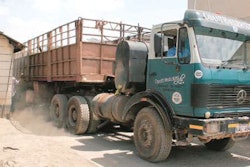 Driver and truck shortages could develop this year. (Photo Max Kvidera)
Driver and truck shortages could develop this year. (Photo Max Kvidera)Beginning this year and continuing into 2012, there will be a shortage of truck drivers, the result of a modestly growing economy and tighter government regulation of drivers. In turn, the shortage will create trucking capacity problems in the years ahead.
That’s the forecast of Noel Perry, managing director and senior consultant at FTR Associates, presented April 8 at an FTR online freight outlook seminar.
Perry noted carriers have cut overhead by removing trucks from service and laying off drivers, and have been slow to reverse the trend. “It’s almost certain that as the marketplace expands, even slowly as we’re forecasting, there will be a driver shortage,” Perry said. “If there’s a driver shortage, that means there’s a truck shortage.”
Perry estimated the driver shortage could be close to 200,000 this year and could grow to about 400,000 in 2011 and 2012.
The trucking economist forecast trucking growth of 4 to 6 percent over the next three years, a good growth rate compared with average figures for the last 30 years but conservative measured against previous upturns, during which growth in some quarters reached 10 percent or better.
“Despite conservative growth estimates, we are explicitly forecasting capacity problems,” Perry said.

He said the capacity shortage will result because the demand for drivers will exceed the system’s ability to provide drivers. “We’re not talking about availability of candidates but the industry’s ability to process candidates,” Perry said, including training, drug testing and processing.
Although delayed, the Federal Motor Carrier Safety Administration’s Comprehensive Safety Analysis 2010 will help sideline some drivers and increase processing time for carriers hiring new employees.
Current heavy truck capacity utilization is slightly above 75 percent and will have to get at least to 85 percent before it will have an impact on truck sales. “It’s going to take a long time before we get up to significant new truck sales,” Perry said.
In last nine months or so, fleets have been able to right-size their capacity to effectively match shipper demand for trucks. There is still a big surplus of used trucks parked in lots, but the number of trucks actively competing for freight is at equilibrium. “They right-sized like crazy,” Perry said.
Current spot market shipping rates are tracking with rates in 2006 and 2008. “We are back to a normal seasonal pattern in 2010 [for spot market prices],” Perry said.
The manufacturing sector is more cyclical than the finished goods, or retail, sector and will recover faster from this recession, Perry said. Manufacturing will likely grow more rapidly over the next 10 years. “Manufacturers will look better than WalMart for a change,” he said.












